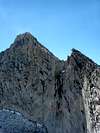|
|
Route |
|---|---|
|
|
37.96720°N / 119.3192°W |
|
|
Technical Rock Climb |
|
|
A long day |
|
|
5.6 II |
|
|
Approach
Refer to this annotated map. Most people start from the Saddlebag Lake dam. Follow the trail along the west shore of the Lake. Before crossing the outlet stream of Greenstone Lake, turn left (west) and traverse the south shore of Greenstone Lake. Follow a good use trail uphill, pass the waterfall above Greenstone Lake, and traverse the north shore of the lowest of the Conness Lakes. Continue on to the north shore of the highest (10743') of the Conness Lakes. Follow a use trail up a scree slope, roughly toward North Peak, which is the prominent summit to the north. After climbing 500 feet or so, begin traversing southwest, toward the broad hump along the connecting ridge between Mount Conness and North Peak. Aim for the obvious low point along the ridge. Be forewarned: If you go too high, you waste energy; too low and you hit cliffs.Traverse south for about 1/2 mile along the flat part of the connecting ridge. This section is consistent class 3 scrambling, with an airy feel and wonderful views.
Eventually the ridge steepens as you approach the "first tower" described by Secor. Secor considers everything but the "several pitches" on the North Ridge proper as "approach", so be careful: if you rope up here, the climb starts looking like a grade III, and not the grade II in Secor's book. The lower section of the first tower merits a solid class 4 rating. Near the top, the climbing steepens. I climbed my hardest pitch of the day here, but don't waste your time. The best alternative is to traverse the east slope of the first tower and aim for the low point on the ridge between the first and second towers. Be prepared for class 4 moves with stunning exposure.
The "second tower" of Secor's book is similar to the first: class 4 in the lower sections, steeper along the ridge near the top. You can find class 4 routes up the right (northwest) slopes of the second tower, but be prepared for loose rocks. At the top of the second tower, you'll find sheer dropoffs and a rappel anchor (pretty nice; 4 slings+2 rings).
Route Description
In Secor, the route is assumed to start at the summit of the second tower, although you have just done an extended class 4+ scramble to get here. Two rappels get you to the "notch" between the second tower and the North Ridge. Downclimbing these two pitches rates 5.6 and is the crux of the entire route.Scramble as high as possible from the notch and rope up (if not soloing). Secor's advice is to "follow the crest of the ridge to the summit". While it is not always possible to follow the ridge exactly, you know you're on route if, on each pitch, you're treated to a view or two down the 1000'+ drop to Conness Glacier. Most of the climbing is class 4 with short sections up to 5.4. Secor's "several pitches" description is understandably vague. Rope drag often dictates short pitches. Most parties should expect 4-8 in total.
Most parties descend back to Saddlebag Lake via the East Ridge.
Variation: an airy traverse
Near the end of the route, you top out at a very exposed belay stance on the ridge. There are a couple towers above you, separated by a very prominent "window". Don't climb the second (closer to the summit) tower. It cliffs out pretty badly. When we did the North Ridge, we rappelled from the belay (looked like 5.3-5.6 terrain), traversed along the west side of the ridge, and soloed one final 5.0 pitch to the summit. This wasn't great climbing, since you necessarily drop down a bit from the main ridge.
However, there is a great variation. Downclimb (or rap) into the window between the two towers. There's a huge area to comfortably stand on. Then venture out onto the east side of the ridge and do the traverse shown in this photo. From the author's research, the traverse is airy, but not difficult.
Essential Gear
- Water - Conness Lakes is last viable source (no treatment needed).
- A map and/or good knowledge of the descent routes.
- Warm and waterproof clothes! Winds over the N. Ridge can be stunning, and Mount Conness often makes its own weather.
- Helmet optional. No serious freeze-thaw rockfall.
- Pro: Not much. Most pitches require no more than 2-5 pieces. Rock is highly fractured and usually accepts nuts readily, but some cracks and flakes are somewhat flared, so take a few cams to 2". Lots of webbing for rappels and girth hitching to rocks at belays.

















mpbro - Oct 17, 2008 7:01 pm - Hasn't voted
ThxThanks for the update--fixed now. Uncovered a systemic problem in the webserver that's hosting me. Unfortunately I no longer control my destiny there! And great work on the North Ridge. That was my second backcountry technical climb, and I guess the last (until I do it again). We did about half of the return in the dark.